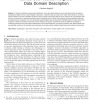Free Online Productivity Tools
i2Speak
i2Symbol
i2OCR
iTex2Img
iWeb2Print
iWeb2Shot
i2Type
iPdf2Split
iPdf2Merge
i2Bopomofo
i2Arabic
i2Style
i2Image
i2PDF
iLatex2Rtf
Sci2ools
IDA
2005
Springer
2005
Springer
Condensed Nearest Neighbor Data Domain Description
—A simple yet effective unsupervised classification rule to discriminate between normal and abnormal data is based on accepting test objects whose nearest neighbors’ distances in a reference data set, assumed to model normal behavior, lie within a certain threshold. This work investigates the effect of using a subset of the original data set as the reference set of the classifier. With this aim, the concept of a reference-consistent subset is introduced and it is shown that finding the minimum-cardinality referenceconsistent subset is intractable. Then, the Condensed Nearest Neighbor Domain Description (CNNDD) algorithm is described, which computes a reference-consistent subset with only two reference set passes. Experimental results revealed the advantages of condensing the data set and confirmed the effectiveness of the proposed approach. A thorough comparison with related methods was accomplished, pointing out the strengths and weaknesses of one-class nearest-neighbor-based trai...
| Added | 27 Jun 2010 |
| Updated | 27 Jun 2010 |
| Type | Conference |
| Year | 2005 |
| Where | IDA |
| Authors | Fabrizio Angiulli |
Comments (0)

